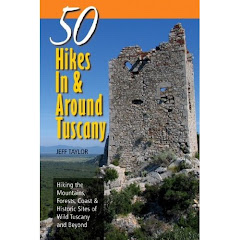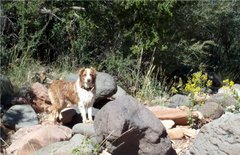Distance: 1.8 miles (2.9 km) roundtrip
Elevation: 820 - 690 feet (250 - 210 m)
Difficulty: Easy
Time of Year: Any Time
Hamilton Pool Preserve is located in the Texas Hill Country about 30 miles west of Austin. It is a spectacular site with a 50-foot cascading waterfall dropping off a ledge into a beautiful turquoise pool with a deep alcove behind it. It is a Travis County Park and is a very popular place for swimming in the hot summer months.
We were camping nearby during our visit with my high school buddy Samy and his family and decided to check it out. The entrance fee is $10 per vehicle. While that seems steep at first, once you hike down to the pool, the admission price suddenly becomes worth it.
The trail leaves from the parking area amongst an arid live oak/juniper savanna. As you walk across this grassland and down the limestone slope, you have no idea what is in store for you.
Within 1/4th of a mile, you descend down to the bottom of the ravine. Upon arrival, you will encounter towering bald-cypress emerging from the creek bed. These cypress indicate that you are in the transition zone between the humid swamps of the southeast and the arid landscapes of the southwest.
The main reason the landscape above seems so arid is because the limestone bedrock is so well drained that even with sufficient rainfall, it drains so rapidly that it is arid for the plants. But, down in the cool ravine with ample water, not only can bald-cypress and palmettos grow, but epiphytic air plants can survive on the humid summer air.
Once you arrive at the pool, the trail will loop under the alcove and all the way around the pool. Giving you every angle for photography.
After admiring the pool and cooling down in the waters, if it is hot, then you can take the trail following the creek 0.6 miles down to the Pendernales River. The trail follows the rocky edge of the ravine past large live oaks, aromatic red bay, juniper, and hackberries.
The trail will come near several stagnant areas with large bald-cypress. Watch for Spanish moss and other epiphytes growing on the branches. These epiphytes are not parasites and they are not lichens or moss. They are in fact flowering plants in the Bromeliad family. They do not harm the tree in any way and acquire all of their moisture from rain or the humidity in the air, plus nutrients from blowing dust.
As you arrive at the Pendernales River, you will encounter a shallow sandy bottomed creek with large boulders sticking out of it. If the current isn't too strong, this would be another great place to go swimming in summer.
All you need to do is backtrack from the river the way you came and back up to the parking area. You can leave the lush environment of the creek bottom and return to that arid environment of cactus and grass on the ridgetop to be reminded of where you really are.


























































